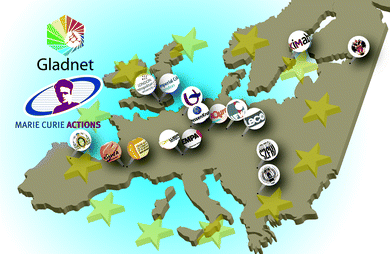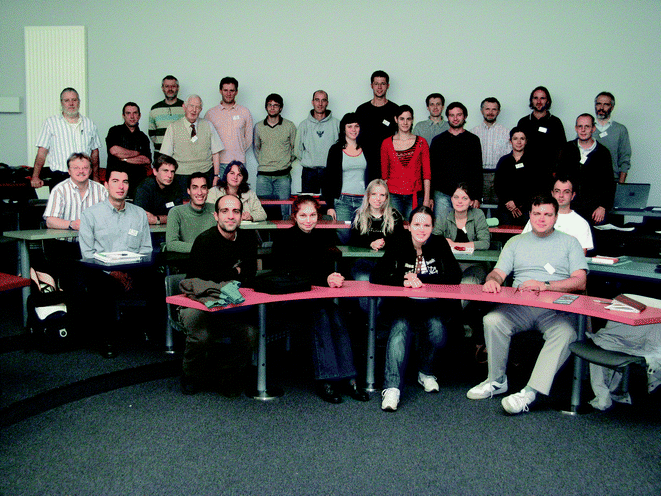Weaving the glow discharge net
Gerardo
Gamez
*
Swiss Federal Laboratories for Materials Science and Technology (EMPA), Feuerwerkerstr. 39, CH-3602, Thun, Switzerland. E-mail: gerardo.gamez@empa.ch
Before continuing, a brief description of the network is necessary, but for a more detailed overview please see reference 1 or you could also visit http://www.gladnet.eu. GLADNET stands for Analytical Glow Discharge Network and it is a Marie Curie Research Training Network funded by the European Commission (EC) under the FP6 program (MRTN-CT-2006-035459). It was composed of 16 partners, including research institutes, academic institutions and industrial firms, from 11 countries (Figure 1). The scientific objectives of the network were to further the analytical capabilities of glow discharge spectroscopy and to rectify the fragmentation of research in the field by bringing together leading European groups. However, as already mentioned above, GLADNET was a research training network and as such the educational objectives were to produce the next generation of glow discharge scientists with experience across the fundamental and applied aspects of the field, as opposed to the more common practice of favoring one over the other. This was accomplished by taking advantage of a mobility framework where the Marie Curie Fellows (MCFs) had prolonged stays at other partners' laboratories, thus promoting collaboration. Also, the MCFs followed a training program with biannual short courses on relevant scientific and career development topics.
 | ||
| Fig. 1 Map of GLADNET participants. Research institutes: Swiss Federal Laboratories for Materials Science and Technology (EMPA Thun, Switzerland); Leibniz Institute for Solid State and Materials Research (IFW Dresden, Germany); Research Institute for Solid State Physics and Optics (RISSP Budapest, Hungary); Corrosion and Metals Research Institute (KIMAB, Sweden). Higher education: Imperial College of Science, Technology and Medicine (ICSTM Physics Dept., UK); University of London Metropolitan (ULMET DCCTM, UK); University of Antwerp (UA Chemistry Dept., Belgium); University of Oviedo (UNIOVI Chemistry Dept., Spain); St. Petersburg State University (SPSU Chemistry Dept., Russia); University of Belgrade (FoPB Faculty of Physics, Serbia); Jean-Francois Champollion University (JFC DPHE, France). Industrial firms: AQura GmbH (Degussa AG, Germany); LECO Instrumente Plzen (spol s.r.o. Czech Rep.); Thyssen Krupp Steel AG (TKS, Germany); Shiva Technologies Europe (STE, France); TOFWERK AG (Switzerland). | ||
Overall, GLADNET harboured 18 early stage researchers (ESRs, the majority working toward their PhD) and 5 experienced researchers (ERs, or post doctoral fellows). From the ESRs eight completed 3 year fellowships, five had approximately 1 year fellowships and the remaining five had only short stays of less than six months. One of the main purposes of the ERs was to allow adequate transfer-of-knowledge especially in research areas where more experience was required to jumpstart different projects.
If one compares closely the plan in reference 1 to what I just described, two main differences jump out. First, the official partner list originally included Indiana University, Bloomington, but for some reason or another it could not be made official. Fortunately, this did not deter the participation of Gary Hieftje in training events for GLADNET and even hosting an ER in his laboratory for a short visit. In addition, this situation gave the network the opportunity of adding another partner at the Jean-Francois Champollion University (JFC) in Albi, France, which proved to be very fruitful. Second, originally there were supposed to be only 10 ESRs with 3-year fellowships. However, life is unscripted and at some point the lives of a couple of these long term ESRs stopped coinciding with that of the network. However, this gave way to several other ESRs to be included in the network and in this manner more fellows got to take advantage of what GLADNET had to offer.
So far, GLADNET has produced more than 50 papers on studies covering fundamental (modelling and spectroscopy) as well as method and instrument development aspects of analytical glow discharges. I say “so far” because at the time this editorial was written there was still some time left in the GLADNET project and a lot of the results that have already been obtained are still making their way into scientific journals. In addition, GLADNET members have consistently used the most important venues for disseminating such work and promoting collaboration including the Winter Conference on Plasma Spectrochemistry (both in Europe and US), Colloquium Spectroscopicum Internationale (CSI), European Conference on Applied Surface and Interface Analysis (ECASIA), Europhysics Conference on Atomic and Molecular Physics in Ionized Gases (ESCAMPIG), International Conference on Plasma Science (ICOPS), Federation of Analytical Chemistry Spectroscopy Societies (FACSS), Nordic Conference on Plasma Spectrochemistry, International Conference on Spectral Line Shapes, and many others. In late August 2010, the first International Glow Discharge Spectroscopy Symposium (IGDSS) held in Albi, France, (organized by GLADNET) served as a platform for leading scientists and users to come together and discuss relevant issues, disseminate the latest developments in the field and foment collaboration. IGDSS gave an opportunity for almost all GLADNET researchers to present a recollection of their work, some of which is featured in this themed issue of JAAS.
Selected works from GLADNET come to mind not only because of their quality but also because they reflect different aspects of the network. The following studies show the concerted efforts of different partners coming together to make the work possible. For example, in a study on the investigation of the pre-peak in pulsed rf GDOES through time resolved measurements, by Deborah Alberts (ESR), partners at the University of Oviedo (UniOvi), the Swiss Federal Laboratories of Materials Science and Technology (EMPA) in Thun, and JFC in Albi, contributed to accomplish the work.2 In the paper by Varvara Efimova (ESR) on the effect of the anode material on the characteristics of a GD cell, two other ESRs at two different partners, the Leibniz Institute for Solid State and Materials Research in Dresden (IFW) and the Research Institute for Solid State Physics and Optics in Budapest (RISSP), collaborated to complete the study.3 Perhaps the best example of collaborative effort is the study by Petr Smid (ER) on the effect of hydrogen and nitrogen on titanium and iron atomic emission spectra in analytical glow discharges, which involved partners at the London Metropolitan University (ULMET), LECO Instrumente Plzen (LECO), Imperial College of Science, Technology and Medicine (ICSTM), and IFW.4 However, GLADNET was not conceived to be an exclusive-club but a network to stimulate collaboration between different groups irrespective of their status as partner and this can be seen in the work on coupling laser ablation and GDMS by Mohamed Tarik, from Detlef Gunther's group at ETH Zurich, who was not a GLADNET full partner but collaborated with partners at TOFWERK AG and EMPA Thun to achieve the work.5 A different aspect of the network is exemplified by the manuscript of Maxim Voronov (ER) on implementing microsecond pulsed GD on sector field mass spectrometers at AQura GmbH, which shows how industrial partners can contribute their expertise and facilities for instrument development and transfer-of-knowledge in this type of European project.6 It is also important to show that the original mission of the ERs to aid in the transfer-of-knowledge was achieved, for example by looking at one of the studies2 mentioned above with the participation of Peter Horvath (ER) or at the manuscript by Viktoria Weinstein (ESR), with the participation of Petr Smid, where the spectroscopic characteristics of flat vs hollow cathode glow discharges are explored.7 In addition, work from the network has been recognized in different venues, for example, Vasilka Steflekova, ESR at the University of Belgrade, Faculty of Physics (FoPB), received an award at CSI XXXVI for her poster presentation that would serve as the basis for her paper exploring the effects of the surface oxide layer on an aluminium cathode on the shape of the H-alpha lines in glow discharge.8 Annemie Bogaerts, Responsible Scientist at the University of Antwerp (UA), published an exceptional piece on modelling of Grimm-type GDs in argon-hydrogen mixtures, featured as a Hot article and on the inside cover of JAAS.9 I could really go on-and-on, unfortunately, I only have a few editorial lines and it is not my intention to review all the studies performed during GLADNET, but rather depict different aspects of the network through certain studies. Thus, I apologize for leaving out a lot of great works and instead invite you to read all the studies made possible by GLADNET perhaps starting with the ones featured in this issue. However, before continuing I would like to point out that it only takes a look at a few studies to see one of the aspects for which GLADNET was celebrated: equal opportunity. It was one of the purposes of the program to promote gender balance in science and this was certainly the case in GLADNET.10
At this stage I would like to highlight the organization and management requirements of such a large network (in fact, the EC puts a significant weight on the proposed managing structure when considering funding such projects). I will do so by acknowledging the people who lead those tasks. First and foremost, Prof. Edward Steers (Training Manager), for being the major driving force during the proposal writing and everything involving training, and always keeping partners motivated. He truly is the “Science Angel” of GLADNET and without his dedication GLADNET would not have been possible. Dr. Johann Michler for overseeing the smooth sailing of the network and being the liaison between the network and the EC project officer while serving as GLADNET's Coordinator until March, 2010. Dr. Stephen Fahlbush for serving as network Manager until June, 2009, thus ensuring daily that the administrative and financial gears were well greased and turning. Dr. Thomas Nelis, for serving at the beginning of the network as Manager and keeping the communication lines of the network in shape throughout the project thus promoting visibility and knowledge transfer. Dr. Volker Hoffmann (Recruitment Manager) for supervising everything related to acquiring the best human resources. Special thanks goes also to the Steering and Training Committees for all their hard work and efforts ensuring that the fellows' and partners' interests were well represented. Nevertheless, the network only came alive because of the contributions from fellows and partners thus it is clear that they are the ones who should really be acknowledged. I was fortunate enough to join the GLANDET family, who received me with open arms, by serving as Manager and Coordinator for the remainder of the project, which made me truly appreciate the work of not only my predecessors, but everyone involved, and for this I would like to say, Thank You! Please enjoy the themed Issue.
GLADNET kick-off meeting in Taormina, Italy, 2007. The excitement was palpable.
References
- N. Jakubowski, E. Steers and A. Tempez, J. Anal. Atom. Spectrom., 2007, 22, 715–721 RSC.
- D. Alberts, P. Horvath, T. Nelis, R. Pereiro, N. Bordel, J. Michler and A. Sanz-Medel, Spectrochim. Acta B, 2010, 65, 533–541 CrossRef.
- V. Efimova, A. Derzsi, A. Zlotorowicz, V. Hoffmann, Z. Donko and J. Eckert, Spectrochim. Acta B, 2010, 65, 311–315 CrossRef.
- P. Smid, E. Steers, Z. Weiss, J. Pickering and V. Hoffmann, J. Anal. Atom. Spectrom., 2008, 23, 1223–1233 RSC.
- M. Tarik, G. Lotito, J. A. Whitby, J. Koch, K. Fuhrer, M. Gonin, J. Michler, J. L. Bolli and D. Guenther, Spectrochim. Acta B, 2009, 64, 262–270 CrossRef.
- M. Voronov, T. Hofmann, P. Smid and C. Venzago, J. Anal. Atom. Spectrom., 2009, 24, 676–679 RSC.
- V. Weinstein, E. B. M. Steers, P. Smid, J. C. Pickering and S. Mushtaq, J. Anal. Atom. Spectrom., 2010, 25, 1283–1289 RSC.
- V. Steflekova, N. M. Sisovic and N. Konjevic, J. Appl. Phys., 2009, 105 Search PubMed.
- A. Bogaerts, J. Anal. Atom. Spectrom., 2008, 23, 1476–1486 RSC.
- J. M. Silva-Rodriguez, Marie Curie Actions: Inspiring Researchers ISBN 978-92-79-14328-1, European-Commission-Directorate-General-for-Research, Luxembourg, 2010 Search PubMed.
| This journal is © The Royal Society of Chemistry 2011 |


